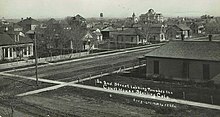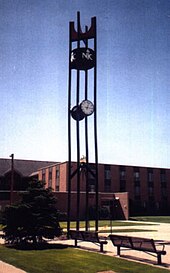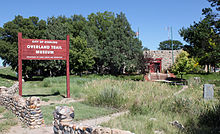Sterling, Colorado
 From Wikipedia - Reading time: 11 min
From Wikipedia - Reading time: 11 min
Sterling, Colorado | |
|---|---|
 Main Street in Sterling. | |
| Nickname: A Colorado Treasure | |
 Location of the City of Sterling in Logan County, Colorado. | |
Location of the City of Sterling in the United States. | |
| Coordinates: 40°37′32″N 103°12′42″W / 40.62556°N 103.21167°W | |
| Country | |
| State | |
| County | Logan County[2] |
| City | Sterling[1] |
| Settled | 1868 |
| Platted | 1890 |
| Incorporated | December 3, 1884[3] |
| Government | |
| • Type | Home rule municipality[1] |
| • Mayor | Matt Foos |
| • City Manager | Kevin L. Blankenship |
| • Police Chief | Tyson Kerr |
| Area | |
• Total | 7.43 sq mi (19.25 km2) |
| • Land | 7.43 sq mi (19.25 km2) |
| • Water | 0.00 sq mi (0.00 km2) 0.0% |
| Elevation | 3,937 ft (1,181 m) |
| Population | |
• Total | 13,735 |
| • Density | 1,800/sq mi (710/km2) |
| Time zone | UTC−7 (MST) |
| • Summer (DST) | UTC−6 (MDT) |
| ZIP code[6] | 80751 |
| Area code | 970 |
| FIPS code | 08-73935 |
| GNIS feature ID | 0202901 |
| Website | City of Sterling |
Sterling is a home rule municipality and the county seat and most populous municipality of Logan County, Colorado, United States.[7] Sterling is the principal city of the Sterling, CO Micropolitan Statistical Area. The city population was 13,735 at the 2020 census.[5]
Sterling is the largest city in the Eastern Plains region of Colorado and the site of the domed Logan County Courthouse, built in 1909.
History
[edit]A post office called Sterling has been in operation since 1874.[8] The community was named for Sterling, Illinois, the native home of a railroad official.[9]

Geography
[edit]Sterling is 128 miles (206 km) northeast of Denver, and is located on Interstate 76, on the 'eastern plains' of northeastern Colorado.
According to the United States Census Bureau, the city has a total area of 7.43 square miles (19.2 km2), all land.
Climate
[edit]According to the Köppen Climate Classification system, Sterling has a semi-arid climate, abbreviated "BSk" on climate maps.[10]
| Climate data for Sterling, Colorado (1981–2010) | |||||||||||||
|---|---|---|---|---|---|---|---|---|---|---|---|---|---|
| Month | Jan | Feb | Mar | Apr | May | Jun | Jul | Aug | Sep | Oct | Nov | Dec | Year |
| Mean daily maximum °F (°C) | 42 (6) |
46 (8) |
56 (13) |
64 (18) |
74 (23) |
84 (29) |
91 (33) |
89 (32) |
80 (27) |
67 (19) |
53 (12) |
42 (6) |
66 (19) |
| Mean daily minimum °F (°C) | 14 (−10) |
18 (−8) |
26 (−3) |
35 (2) |
46 (8) |
56 (13) |
61 (16) |
59 (15) |
48 (9) |
35 (2) |
24 (−4) |
15 (−9) |
36 (3) |
| Average precipitation inches (mm) | 0.30 (7.6) |
0.36 (9.1) |
0.96 (24) |
1.33 (34) |
2.31 (59) |
2.76 (70) |
2.66 (68) |
1.88 (48) |
1.18 (30) |
1.09 (28) |
0.54 (14) |
0.34 (8.6) |
15.72 (399) |
| Average snowfall inches (cm) | 4.0 (10) |
4.0 (10) |
3.7 (9.4) |
1.8 (4.6) |
0.0 (0.0) |
0.0 (0.0) |
0.0 (0.0) |
0.0 (0.0) |
0.4 (1.0) |
1.0 (2.5) |
4.1 (10) |
5.8 (15) |
24.8 (63) |
| Source: Weather.com[11] | |||||||||||||
Demographics
[edit]| Census | Pop. | Note | %± |
|---|---|---|---|
| 1890 | 540 | — | |
| 1900 | 998 | 84.8% | |
| 1910 | 3,044 | 205.0% | |
| 1920 | 6,415 | 110.7% | |
| 1930 | 7,195 | 12.2% | |
| 1940 | 7,411 | 3.0% | |
| 1950 | 7,534 | 1.7% | |
| 1960 | 10,751 | 42.7% | |
| 1970 | 10,636 | −1.1% | |
| 1980 | 11,385 | 7.0% | |
| 1990 | 10,362 | −9.0% | |
| 2000 | 11,360 | 9.6% | |
| 2010 | 14,777 | 30.1% | |
| 2020 | 13,735 | −7.1% | |
| U.S. Decennial Census | |||

As of the 2020 census, there were 13,753 people, 4,604 households, and 2,790 families living in the city. The population density was 1,653.1 inhabitants per square mile (638.3/km2). There were 5,171 housing units at an average density of 752.5 per square mile (290.5/km2). The racial makeup of the city was 90.75% Caucasian American, 0.75% African American, 0.79% Native American, 0.41% Asian, 0.08% Pacific Islander, 5.60% from other races, and 1.62% from two or more races. Hispanic or Latino of any race were 14.20% of the population.
There were 4,604 households, out of which 30.6% had children under the age of 18 living with them, 46.2% were married couples living together, 10.8% had a female householder with no husband present, and 39.4% were non-families. 34.1% of all households were made up of individuals, and 14.7% had someone living alone who was 65 years of age or older. The average household size was 2.34 and the average family size was 3.03.
In the city, the population was spread out, with 25.5% under the age of 18, 12.9% from 18 to 24, 25.5% from 25 to 44, 19.6% from 45 to 64, and 16.4% who were 65 years of age or older. The median age was 35 years. For every 100 females, there were 94.7 males. For every 100 females age 18 and over, there were 91.2 males.
The median income for a household in the city was $27,337, and the median income for a family was $39,103. Males had a median income of $27,921 versus $20,508 for females. The per capita income for the city was $15,287.
Economy
[edit]

Major employers in Sterling include Northeastern Junior College, the RE-1 Valley School system, and the Sterling Correctional Facility.[citation needed]
Sterling is the major shopping hub for most of northeastern Colorado and hosts big box retailers, as well as many local stores located primarily on Main Street. Six different banks have branches in Sterling and there are local AM and FM radio stations as well as a local television station, and a long-established regional newspaper, the Sterling Journal-Advocate and South Platte Sentinel [1].

Government
[edit]The Colorado Department of Corrections operates the Sterling Correctional Facility in Sterling.[12]
Education
[edit]Sterling is the home of Northeastern Junior College. Sterling is also the location of the RE-1 Valley School District.
Infrastructure
[edit]Transportation
[edit]Crosson Field serves as Sterling's airport, but there are no scheduled commercial flights available from there. The closest airport served by scheduled flights is Denver International Airport, located 121 miles (195 km) away.
Sterling is also served by railroads, although only freight carriers serve the town. The main rail operator is Burlington Northern Santa Fe (BNSF), but other operators, like Union Pacific, serve Sterling as well. The closest Amtrak station is located in Fort Morgan, Colorado, about 47 miles (76 km) away.
Intercity bus service is offered by Burlington Trailways and Express Arrow with service to Denver, as well as a number of cities in Nebraska including North Platte, Kearney, and Omaha. Sterling is also part of Colorado's Bustang network, as the eastern terminus of the Sterling–Denver and Sterling–Greeley routes, which operate two days per week and three days per week respectively.[13]
Highways
[edit] Interstate 76 connects Sterling to Denver (128 miles (206 km) southwest) and northeast to Interstate 80, in Big Springs, Nebraska, along the South Platte River.
Interstate 76 connects Sterling to Denver (128 miles (206 km) southwest) and northeast to Interstate 80, in Big Springs, Nebraska, along the South Platte River. Business Loop 76 starts on the intersection of Interstate 76 and US 6, going through East Chestnut Street, North and South 4th Street, South Division Avenue, returning to US 6, connecting Sterling to Atwood and Merino.
Business Loop 76 starts on the intersection of Interstate 76 and US 6, going through East Chestnut Street, North and South 4th Street, South Division Avenue, returning to US 6, connecting Sterling to Atwood and Merino. US 6 runs east–west linking Provincetown, Massachusetts with Bishop, California, via Nevada, Colorado, Illinois and 8 other states.
US 6 runs east–west linking Provincetown, Massachusetts with Bishop, California, via Nevada, Colorado, Illinois and 8 other states. US 138 Runs parallel to Interstate 76, connecting Sterling to US 30, north of Big Springs, Nebraska.
US 138 Runs parallel to Interstate 76, connecting Sterling to US 30, north of Big Springs, Nebraska. State Highway 14 connects Sterling to Fort Collins located 102 miles (164 km) to the west.
State Highway 14 connects Sterling to Fort Collins located 102 miles (164 km) to the west.
Health care
[edit]Sterling is a regional center for health care as well and is the home of Sterling Regional MedCenter (SRMC).
Media
[edit]Radio
[edit]See also
[edit]References
[edit]- ^ a b c "Active Colorado Municipalities". State of Colorado, Colorado Department of Local Affairs, Division of Local Government. Retrieved January 27, 2021.
- ^ "Colorado Counties". State of Colorado, Colorado Department of Local Affairs, Division of Local Government. Retrieved January 27, 2021.
- ^ "Colorado Municipal Incorporations". State of Colorado, Department of Personnel & Administration, Colorado State Archives. December 1, 2004. Retrieved September 2, 2007.
- ^ "2019 U.S. Gazetteer Files". United States Census Bureau. Retrieved July 1, 2020.
- ^ a b United States Census Bureau. "Sterling city; Colorado". Retrieved April 21, 2023.
- ^ "ZIP Code Lookup". United States Postal Service. Archived from the original (JavaScript/HTML) on November 22, 2010. Retrieved January 5, 2008.
- ^ "Find a County". National Association of Counties. Retrieved June 7, 2011.
- ^ "Post offices". Jim Forte Postal History. Retrieved July 11, 2016.
- ^ Dawson, John Frank (1954). Place names in Colorado: why 700 communities were so named, 150 of Spanish or Indian origin. Denver, CO: The J. Frank Dawson Publishing Co. p. 48.
- ^ Climate Summary for Sterling, Colorado
- ^ "Average Weather for Sterling, Colorado - Precipitation and Temperatures". Weather.com. Retrieved October 22, 2014.
- ^ "SCF - Sterling Correctional Facility." Colorado Department of Corrections. Retrieved on April 19, 2012. "Facility Location: 12101 Hwy 61 Sterling, CO, 80751"
- ^ "Bustang Outrider Schedules & Rates" (PDF). Colorado Department of Transportation. Retrieved October 5, 2023.
- ^ "97.5 Bob FM".
- ^ "BOB FM | 80s, 90s... and whatever!". Retrieved March 15, 2022.
- ^ "FM Station KSRX - FCC Public Inspection File". publicfiles.fcc.gov. Retrieved March 15, 2022.
 KSF
KSF
